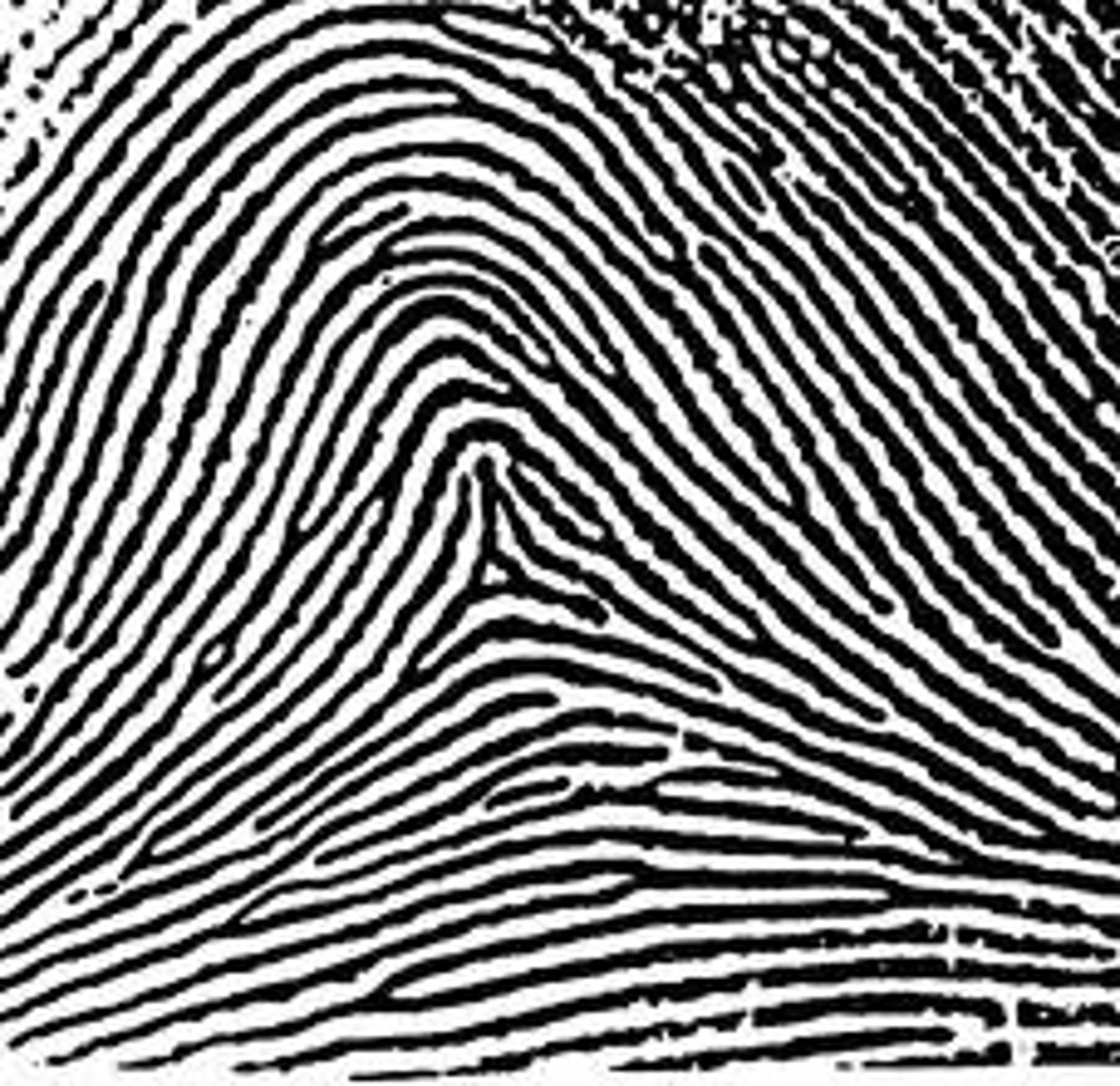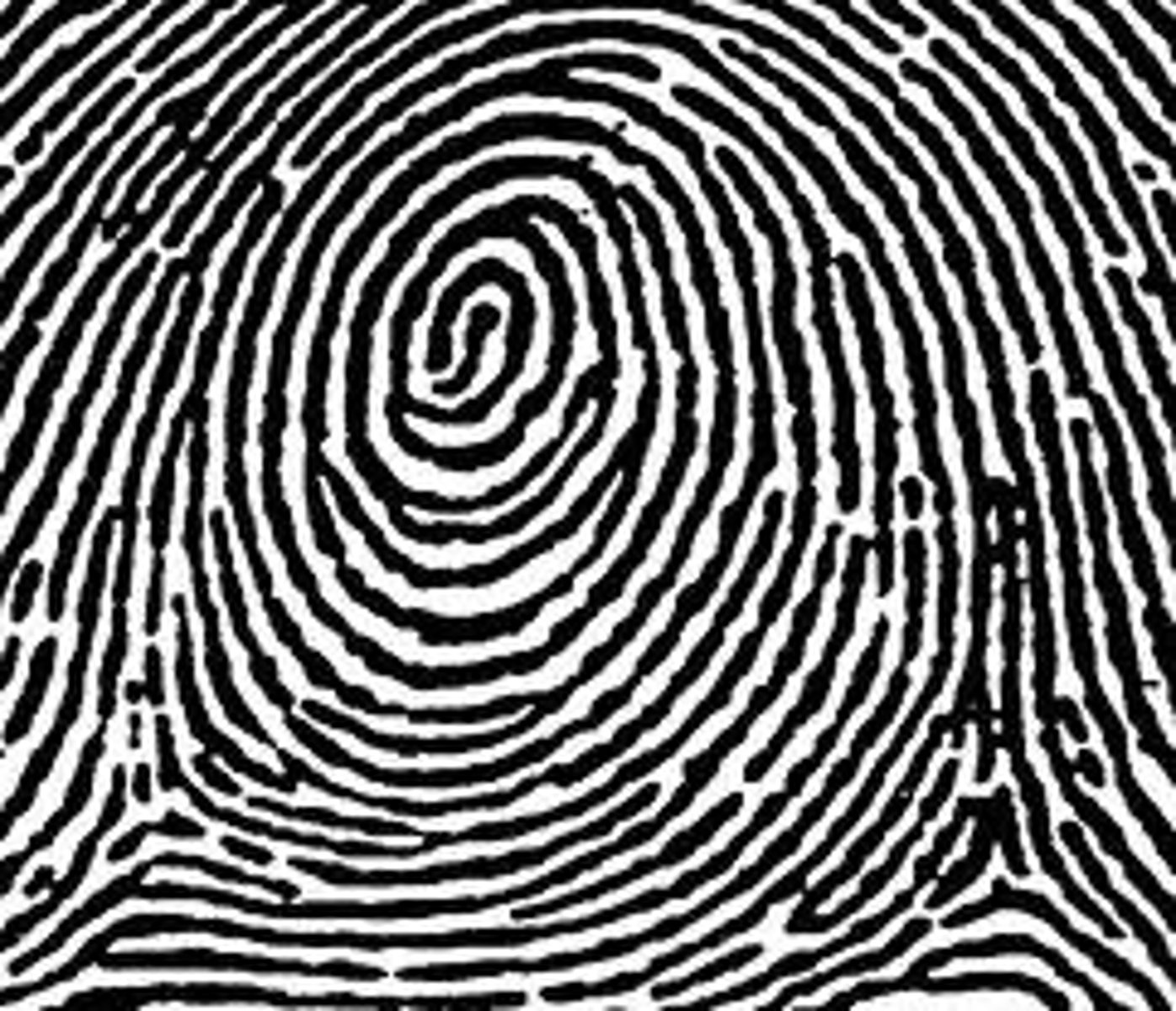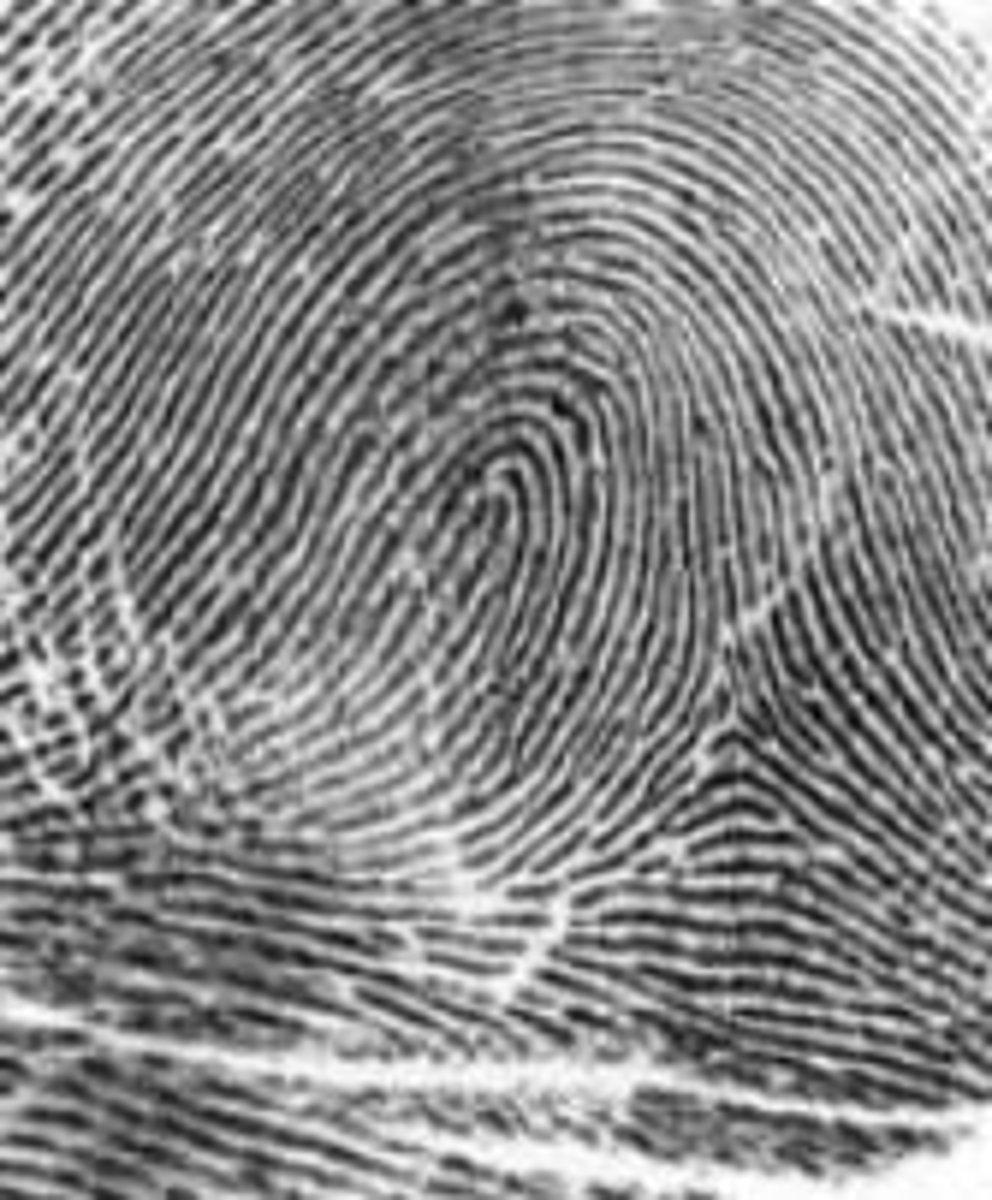PLTW: Biomedical Science Unit 1.1
1/78
There's no tags or description
Looks like no tags are added yet.
Name | Mastery | Learn | Test | Matching | Spaced |
|---|
No study sessions yet.
79 Terms
5 steps to a crime scene investigation
1. Collect evidence
2. Sketch
3. Interview
4. examine
5. photograph
4 parts to a crime scene
sketch, legend, key, scale
3 primary fingerprint ridge patterns
arch, whorl, loop
arch

whorl

loop

7 steps to experimental design
1. Identify the problem or question
2. Predict a solution to the problem or an answer to the question
3. Design an experiment to test your hypothesis
4. Carry out the experiment
5. Analyze the data and observations
6. State the conclusion
7. Complete a summary paragraph
Independent variable
Variable that is varied or manipulated by the researcher.
Dependent variable
Measurable effect, outcome, or response in which the research is interested. results vary based on the independent variable.
Biomedical Science
The application of the principles of the natural sciences, especially biology and physiology, to clinical medicine.
Control Group
The group in an experiment that serves as a comparison against the experimental group where the independent variable is applied.
Experiment
A research study conducted to determine the effect that one variable has upon another variable.
Forensic Science
The application of scientific knowledge to questions of civil and criminal law.
Hypothesis
Clear prediction of the anticipated results of an experiment.
Negative Control
Control group where conditions produce a negative outcome.
Personal Protective Equipment
Specialized clothing or equipment, worn by an employee for protection against infectious materials (as defined by OSHA).
Positive Control
Group expected to have a positve result, allowing the researcher to show that the experiment set up was capable of producing results.
Types of Blood
Type A, Type B, Type AB, Type O
Clumping with a serum that is Anti-A indicates
(same with Anti-B)
that the blood type has "A" in it
that the blood type has "B" in it
cuticle
What is the outermost layer of the hair?
cortex
Home to pigment containing granules - gives hair color.
medulla
This layer may be continuous, discontinuous, fragmentary, or even absent. The diameter of the ____________________ is a useful characteristic in the identification and comparison process.
What did the blood stain patterns left near Anna Garcia tell you about her death?
If blood is dropped from a higher height, then the blood spatter diameter increases as a result of the kinetic energy and force of gravity as blood falls to the Earth. (The blood at the crime scene was dropped from table height)
Adenine
A component of the nucleic acids, energy-carrying molecules such as ATP, and certain conenzymes. Chemically, it is a purine base.
Chromosome
Any of the usually linear bodies in the cell nucleus that contain the genetic material.
Cytosine
A component of nucleic acids that carry hereditary information in DNA and RNA in cells. Chemically, it is a pyrimidine base.
Deoxyribonucleic Acid (DNA)
A double-stranded, helical nucleic acid molecule capable of replicating and determining the inherited structure of a cell's proteins.
Gel Electrophoresis
The separation of nucleic acids or proteins, on the basis of their size and electrical charge, by measuring their rate of movement through an electical field in a gel.
Gene
A discrete unit of hereditary information consisting of a specific nucleotide sequence in DNA (or RNA, in some viruses).
Guanine
A component of nucleic acids that carry hereditary information in DNA and RNA in cells. Chemically, it is a purine base.
Helix
Something spiral in form.
Model
A simplified version of something complex used, for example, to analyze and solve problems or make predictions.
Nucleotide
A building block of DNA, consisting of a five-carbon sugar covalently bonded to a nitrogenous base and a phosphate group.
How do scientists isolate DNA to study it?
DNA can be extracted from cells by
1. obtaining cells
2. using detergent to break down the cell and nuclear membranes
3. adding isopropyl alcohol to separate the rest of the cellular materials
How does DNA differ from person to person?
Only the sequence and number of bases separates all organisms.
Human DNA differs only between humans of 0.1%
only identical twins have the same DNA sequence
Restriction Enzyme
A degradative enzyme that recognizes specific nucleotide sequences and cuts up DNA.
Restriction Fragment Length Polymorphisms (RFLPs)
Difference in DNA sequence on homologous chromosomes that can result in different patterns of restriction fragment lengths (DNA segments resulting from treatment with restriction enzymes).
Thymine
A component of nucleic acids that carry hereditary information in DNA and RNA in cells. Chemically, it is a pyrimidine base.
What is DNA?
DNA is the hereditary material in humans and all living organisms. It's a molecule and is holds the imstructions for building all living things.
Give an example of a base pair. Also give the number of bonds the base pair has.
A and T. 2 pairs.
How many base pairs does Cytosine and Guanine have?
3.
C pairs with _______.
G.
T pairs with _______.
A.
What is a nucleotide made up of?
A phosphate, deoxyribose sugar, and a base pair.
What is the difference between the purines and the pryimidines?
Purines have two carbon-nitrogen rings and four nitrogen atoms. Pryimidines have one carbon-nitrogen ring and two nitrogen atoms.
What two base pairs are purines?
Adenine and thymine.
What two base pairs are pyrimidines?
Cytosine and gu
Why do purines bond with pryimidines in the DNA ladder?
They are opposite poles and have the same number of hydrogen bonds.
Activity 1.2.3: What did the results of gel electrophoresis show?
They showed that Anna Garcia was at the crime scene.
Explain the role that restriction enzymes and gel electrophoresis play in DNA profiling.
Restriction enzymes cut the DNA at specific nucleotide sequences and gel electrophoresis seperates nucleic acids or proteins by size.
What would happen if the gel was placed with the DNA starting closest to the positive electrode? Explain.
The process wouldn't work because the DNA would run backwards.
What do restriction enzymes do?
They cut DNA at specific nucleotide sequences.
Who's fingerprint was found at Anna Garcia's crime scene?
Eric P. on note
What does HIPAA stand for?
Health Insurance Portability and Accountability Act
What is HIPAA?
A laws enacted in 1996 designed to give the patients rights.
What are base pairs also called?
Nucleotides
True/False: Chromosomes are composed of genes and chromosomes make up DNA.
True
plasma function
transport of nutrients, blood gases, wastes, hormones, blood cells and platelets
Erythrocytes
red blood cells
Erythrocytes function
transport oxygen from lungs and carbon dioxide as waste. Hemoglobin is protein in the red blood cell that carries the Oxygen
What are leukocytes?
white blood cells
What's the function of leukocytes?
Respond to foreign substances like viruses, bacteria and fungi. React with inflammatory and immune response
Thrombocytes
platelets
Function of thrombocytes
blood clotting, stops bleeding
Presumptive testing
Initial testing that suggests a sample may be blood
Confirmatory Testing
A test that can confirm the identity of a person/substance
Blood transfers
Occur when blood source comes in contact with surface; smears or trails
Splatters
Produced when liquid blood travels through air before landing on target surface
Geneome
all of an organism's genetic material
CODIS (Combined DNA Index System)
National database of DNA data obtained from individuals convicted of sexual assaults or homicides
Who's hair was found at scene
Eric piedmont
Who did the blood belong to at the scene?
Anyone with type A blood, Anna , Eric, Dominique
Who's DNA was found at scene
Anna Garcia
Who fingerprints were found at scene
Eric on note, Anna on glass bottle
From polygraph which individuals may have been lying
Eric and Dominique had indications of lying on questions did you kill Anna and were you getting along with Anna.
What did blood splatter at the scene indicate
Low velocity; 90-70 degrees and and dropped from 170cm height. Circular small droplets
DNA strand will wind around_________
Histones proteins
Eukaryotic cells
Larger, complex, with nucleus, membrane bound organelles, DNA tightly wrapped around histone proteins in chromosomes, found in plants, animals, fungi and proists,
Prokaryotic cells
Small, simple, no nucleus, no membrane-bound organelles, single loop of DNA (nucleoid), no cellulose, cytoplasm, cell membrane, cell wall (made of carbs), somtimes have cilia or flagella (movement). Bacteria